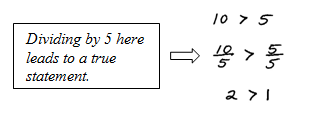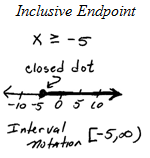So whenever we divide or multiply by a negative number we must reverse the inequality. It is easy to forget to do this so take special care to watch out for negative coefficients.
Notice that we obtain infinitely many solutions for these linear inequalities. Because of this we have to present our solution set in some way other than a big list. The two most common ways to express solutions to an inequality are by graphing them on a number line and interval notation.Note: We use the following symbol to denote infinity:

Tip: Always use round parentheses and open dots for inequalities without the equal and always use square brackets and closed dots for inequalities with the equal.
Video Examples on YouTube:


J. Redden on G+








comment 0 التعليقات:
more_vertsentiment_satisfied Emoticon